Home » Hunting Dogs » Spinone Italiano – Complete History and Development
Spinone Italiano – Complete History and Development
- Country of Origin: Italy
- Parent Club: Club Italiano Spinone
- Population: 500 to 600 pups whelped per year in Italy, several hundred more in UK and US
- Size: Males 60-70 cm & Females 58-65 cm
- Coat: Wire-haired brown and white, orange and white, and all white
- Range: Close to Medium
- Speed: Fast Trot to Medium Gallop
- Retrieve: Excellent
- Water Work: Excellent
- Protection Duty: Poor
- Health Issues: Hip Dysplasia, cerebellar cortical abiotrophy
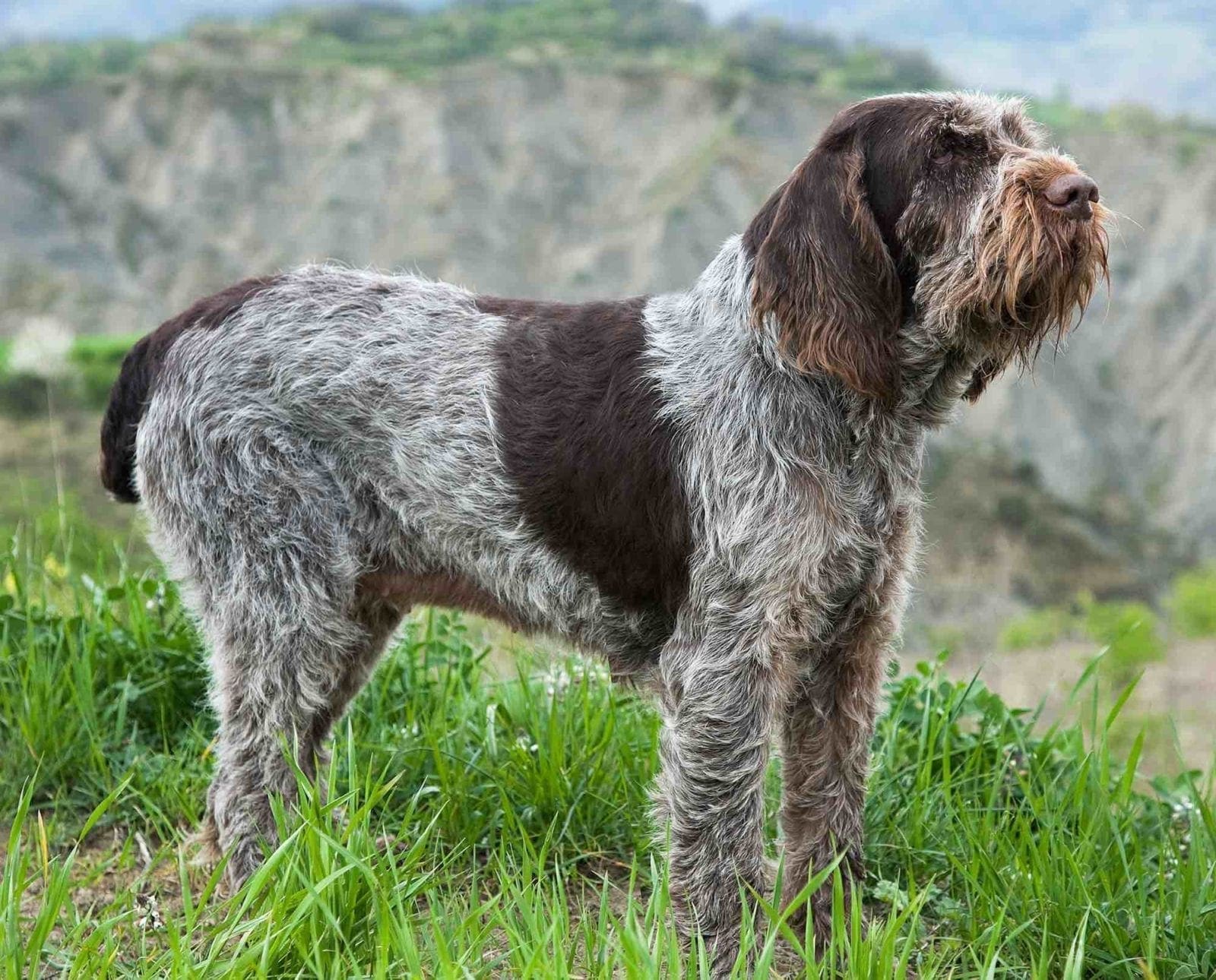
From their home base in Winnipeg, Craig Koshyk and Lisa…
The traditional, rough-haired Italian pointing dog overcame difficult odds to become a modern, versatile hunting dog
I love Italy. I love the food, the wine, the culture, and especially the language, which I speak with an English/French accent so thick you can cut it with a knife. When Lisa and I are in Italy, we live on a steady diet of pizza, pasta, chianti, and cappuccino. And once in a while, when it is really hot, we’ll order a nice cold beer.
Our Italian brew of choice is called Birra Moretti, a perfectly drinkable beer with an interesting picture on the label—an image of a smiling man lifting a frothy mug to his lips. He’s wearing a green suit, green hat, and has a prominent red mustache.
One day, in a small town near Padua, as Lisa and I enjoyed a cool Birra Moretti, I saw a dog and his owner walking across the central square. The dog was fairly large, white and orange, and as it got nearer I realized that it had the same bushy mustache as the Moretti guy! When he and his owner walked by our table, I said, “Excuse me, sir, but what kind of dog is that?”
“È uno Spinone,” he replied. “It is a Spinone.”
History of the Spinone
Just about any history you are likely to find on the Spinone will make the claim that the breed was created in the furthest mists of time. But a few vague references to hunting dogs in obscure Greek poems are not enough to prove an ancient origin.
On the other hand, images found in Renaissance paintings do show that dogs resembling the Spinone were in Italy at least as far back as the 1400s. Perhaps the most intriguing image is one found on the west wall of the Ducal Palace in Mantua. Painted by Andrea Mantegna circa 1474, the fresco is divided into three panels. The left panel shows a horse and four men with hunting dogs that appear to be greyhounds and mastiffs. The right panel, often referred to as “The Meeting,” is said to represent Ludovico Gonzaga, his son, Cardinal Francesco, and other members of his family. In the bottom left corner of the scene, behind Ludovico’s legs, is a small, rough-haired dog that some believe may be an ancestor of the Spinone.
Despite other ancient images featuring dogs that resemble Spinoni, it was not until 1834 that the first written reference to the breed was made by Bonaventura Crippa, who wrote:
We should not forget to mention the hard-coated Bracco commonly called Spinoso.
Many breed histories point to those lines as the first time the Spinone is mentioned in the literature, albeit with a slightly different name. However, they all seem to skip over the very next line where Crippa makes the extraordinary claim that the Spinoso was English!
This species of dog originated in England and is used by us more to hunt in the marshes and the woods.
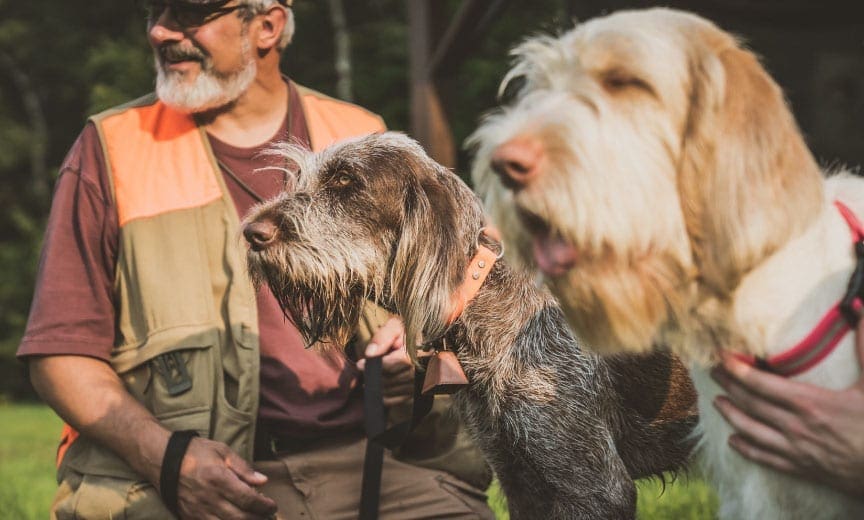
It is not clear how Crippa came to believe that the “hard-coated Bracco commonly called Spinoso” came from England, but he is surely mistaken. Rough-coated dogs had existed in Italy and across all of Europe for centuries, wherever short-coated dogs mixed with long- or curly-coated breeds. In any case, no other work on the Spinone mentions an English connection. All of the major authorities agree that the ancestors of the Spinone were probably native to Italy. In Les Chiens d’Arrêt, author Jean Castaing provides us with the most likely scenario for the development of the breed:
I believe that the Spinone developed in more or less the same way as other such breeds… Like all other pointing griffons was born from the cohabitation of braques and barbets.
By the mid-1800s, Spinoni (plural of Spinone) could be found throughout much of Italy. And like their cousin, the Bracco Italiano, different types were seen in the various regions. In Piedmont and Lombardy, for example, Spinoni tended to have rough brown and white or orange and white coats. In the Veneto area they were said to have had longer and softer brown roan coats.
Not only were there different coat types and colors in various regions, but it seems that just about every noble family was breeding their own versions as well. In I Cani Da Ferma Italiani, Giambattista Benasso wrote:
. . . Many aristocratic families or of higher classes had their own “breed” of Bracchi or Spinoni, simply numerically small families from which they tried to get individuals with the appearance and aptitudes that were required by the local hunting culture and environment.
Despite their many varieties, almost everyone agreed that the Spinone was better suited to the wetlands than the short-haired Bracco. Bonaventura Crippa wrote:
It seems that nature, having granted it a long and rough coat, has specifically destined it to deal with reeds and thorns. Its field search is fairly active and persistent, and a hunter who hunts for birds only in the woods and swamp could benefit far more from it than from the one with short hair that is used in open and arid country.
When tracing the development of the Spinone, it is important to remember that throughout much of the 1800s the entire Italian peninsula underwent massive social, political, and economic changes. Insurrections, revolts, and two wars of independence finally led to Italian unification in 1861. By the 1880s the country had made great progress in terms of education, health care, and political stability. And, like elsewhere in Western Europe, hunting and dog breeding became increasingly popular with the growing middle class.
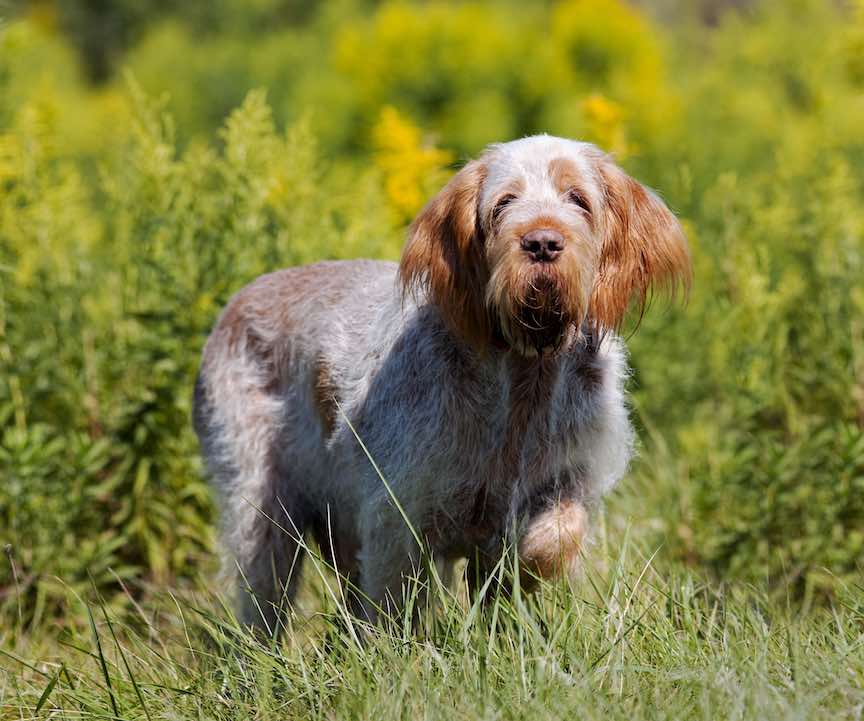
Enter Ferdinando Delor, writer, editor of the influential magazine Caccia e Tiro (Hunting and Shooting) and founding member of the Italian Kennel Club. Among the club’s first tasks was to bring order to the Spinone breed by accepting only dogs that met the newly established official standard. The club also had to decide whether or not to permit crosses to other rough-haired breeds. Delor suggested that crosses to the Stichelhaar—he called it a “German Spinone”—and the Korthals Griffon could lend the Spinone a helping hand. He wrote:
In the, lets us say, miserable state in which our rough-haired breeds are found, these crosses would be advisable…the German Spinone and the Griffon have a great affinity with ours and, if done with intelligence, would not bring overly radical modifications to the look and aptitudes of our Italian dogs. must be careful about the introduction of blood from the Griffon a Poil Soyeux ; once brought in, it is difficult to eradicate.
In Germany and France, many breeders of rough-haired dogs, including Eduard Korthals, believed that all pointing griffons were of the same family and should be allowed to mix. So it is understandable, especially after the First World War, that breeders were encouraged to cross Spinoni with Korthals Griffons, Stichelhaars, and even German Wirehaired Pointers.
So, in 1922, the French and Belgian stud books were opened to the Spinone, which was registered alongside the other griffons. But the situation did not last long. Breeders soon realized that the Spinone brought with it certain characteristics, such as an orange and white coat and dewclaws on the rear legs, that were proscribed in other griffon standards. In addition, many believed that the Spinone had received too much “foreign” blood—mainly from English Pointers—in the recent past, and its standard was moving away from that of the other griffons. The Spinone was therefore removed from the Wirehaired Pointing Griffon stud book and declared a separate and independent breed.
It was around this time, when the breed was struggling to form its own stud book and standard, that the Spinone began to feel the full effects of the massive importations of bird dogs from England, and to a lesser extent from France and Germany. Spinoni numbers declined as Italian hunters turned their attention to these faster, wider-ranging breeds. In an effort to reverse the trend, breeders tried to “modernize” their lines. It is said that crosses to Boulet and Korthals Griffons, German Wirehaired and Shorthaired Pointers, and English Pointers were done at the time, with mixed results. Speed and range increased in some lines, but the look and character of the breed was adversely affected.
If the effects of unregulated crosses hurt the Spinone and the increasing competition from other breeds reduced its numbers, then the Second World War nearly wiped it out. Of course, all the other Continental breeds faced difficult challenges in the post-war years but, for some, recovery was fairly rapid. Not only were breeders able to rebuild the population bases, but they managed to improve the overall hunting ability across the breeds in very short order.
Unfortunately for the Spinone, recovery took considerably longer. In fact, it was not until the 1980s that any real progress was made in terms of field ability. It seems that Spinone breeders were slow to adapt to the rapidly changing hunting scene in Italy. With severe reductions in wild game populations and fewer places to hunt, their breed earned the reputation as an outdated type of dog kept only by older hunters unwilling to change their ways.
To make matters even worse, many breeders had been basing their selection almost completely on the breed’s conformation standard and not on its natural hunting abilities. The few breeders who eventually tried to turn things around had an uphill battle. According to Marino Panizza, quoted by Giambattista Benasso, in I Cani Da Ferma Italiani:
” use the handsome to develop the good in terms of hunting, which of course is a very difficult undertaking. It required years and years of work, but following the path laid out by the late Emilio Pedrazzini, who can be considered the father of modern Spinone, the breed finally rose to a high level.”
Today the Spinone continues to improve and gain ground among hunters in Italy and elsewhere in Europe. The number of field trial champions has risen dramatically over the last 20 years and some Spinoni have even won all-breed trials on the continent. In North America, the Spinone has found a home among a fair number of dedicated NAVHDA breeders who have made excellent progress in recent years.
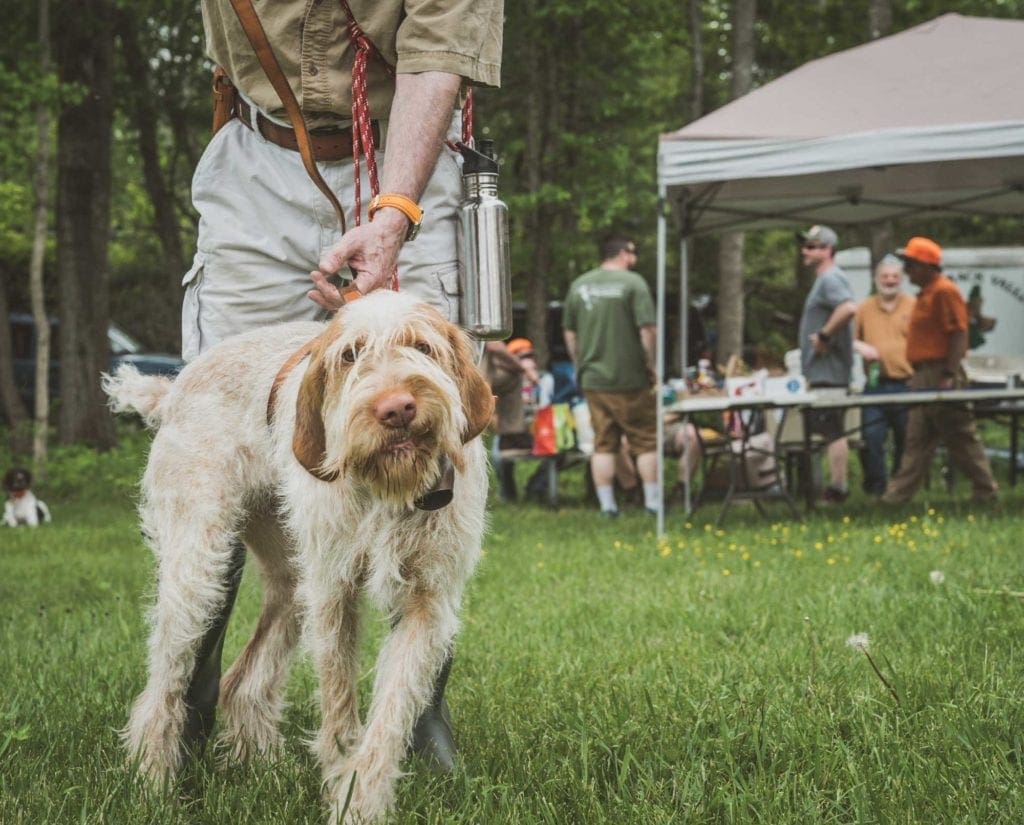
The Story Behind the Name of the Spinone
“Spinone” is derived from the Italian word for thorn: spina. It can refer to the breed’s harsh coat and/or the thorny terrain in which it excels as a hunter. Unlike many of the other Continental breeds, the name is more or less the same in just about any language. The English, French, Dutch, Danish, Spanish, and Germans all call the breed Spinone and use the Italian plural: Spinoni.
During much of the 1800s the most common name for the breed was Bracco Spinoso. Various regional dialects used other terms. In Piedmont, it was the Restone; in Tuscany, the Spinoso; and in the Naples area, Bracco Restoso. In 1887 Ferdinado Delor suggested that the name Spinone be adopted for the breed. The Kennel Club of Italy agreed, and the name was accepted shortly thereafter.
Some English speakers call the breed Italian Spinone or Spinone Italiano. But the term is somewhat redundant. There is only one “Spinone”, so there is really no need to qualify it with the word “Italian.”
Physical Characteristics of the Spinone
Spinoni are fairly large, well-built dogs with a harsh, rough-haired coat and thick beard and mustache. At first sight, they look like a Bracco Italiano with a rough coat, but there are some important differences under the wiry hair. The Spinone can be larger than the Bracco, it has a different head shape, and the ears are somewhat smaller. Like the Bracco, dewclaws on the hind legs are common. The Spinone is unique among the wire-haired Continental breeds in that it should not have an undercoat.
The coat color can be pure white, white with orange markings, white speckled with orange, white with brown (chestnut) markings, roan or brown roan (chestnut). The preferred shade of brown is called tonaca di frate (Friar’s frock), a slightly lighter and more reddish shade of brown than the liver color of the German Wirehaired Pointer. Tricolor, tan, or black markings are not allowed.
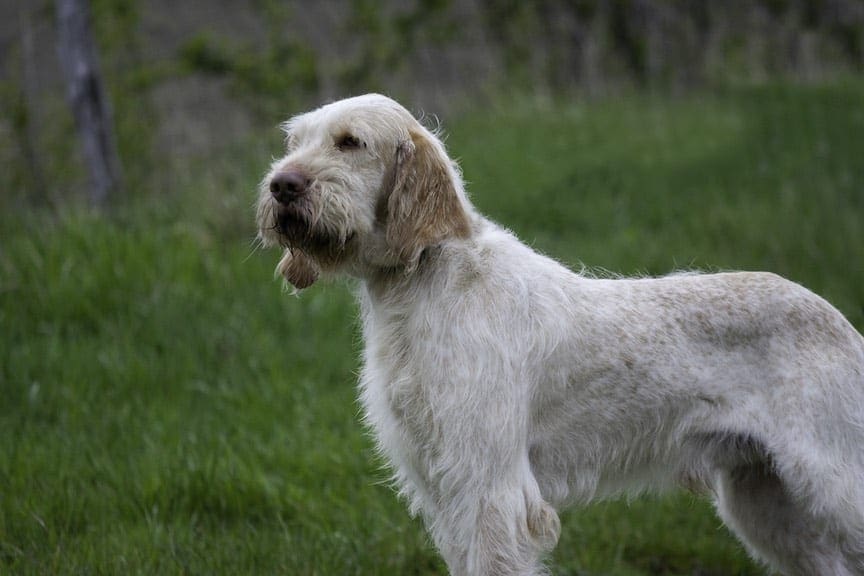
The Spinone’s Hunting Style
Of the two Italian pointing breeds, the Spinone is considered the better choice for hunting in tough conditions. It is renowned for its ability to work all day, in a wide variety of terrains, especially in rough, dense cover or deep water.
In the past, Spinoni were thought of as close range, slow, almost lethargic hunters. However, as Italian breeder Daniele Serafino explains, the old stereotype no longer applies:
We are witnessing a real evolution of the breed nowadays. The conformation standard has remained more or less the same and the sweet character that has been handed down over the centuries is still there. But the working abilities have improved greatly. There are now certain highly developed bloodlines that, in addition to the typical character of the breed, demonstrate a remarkable confidence that translates into a bigger range, faster trot, and very solid and often very sudden points.
The typical field search of the Spinone is similar to that of its cousin, the Bracco Italiano. In fact, much of their working standards is identical. In the field, however, there are differences. The trot of a Spinone is not quite as fast as that of the Bracco. The head is held high, but not as high as a Bracco’s. The rhythm of the trot is more staccato and the rear legs do not extend as far backward with each stride. This type of trot may require less energy and is a fundamental feature of the breed, said to enable it to hunt all day, every day, without tiring. In terms of range, the Spinone should cover a good amount of ground, out to about 100 meters.
Spinoni also tend to show more of a mix of trotting and galloping than the Bracco. Italian field trialers and hunters say that the Bracco is more of a stylist, while the Spinone is more of a versatile “meat dog,” in the best sense of the word.
Spinoni can be excellent water workers. Most are strong swimmers that develop a love for water work early on. The dense and harsh wire-haired coat offers good protection from the cold and from the rough cover of wetland areas. A Spinone may be a good choice for dedicated waterfowlers, but they can be fairly large dogs so may not be the best choice for working out of a tippy canoe.
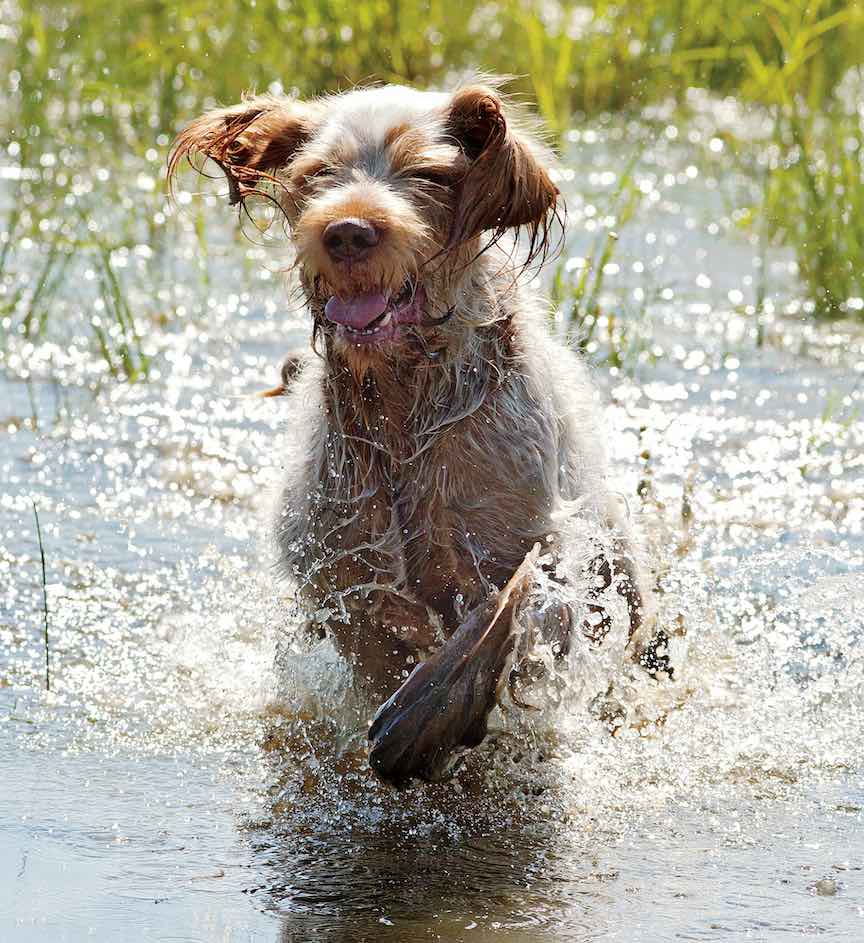
Character and Training Considerations
The words most often used when describing a typical Spinone are lovable, sweet, mellow, easygoing, and affectionate. Spinone are big, rough-and-tumble dogs that may give the impression of being tough as nails. But in terms of temperament many are big softies. Anyone training a Spinone needs to keep this in mind. Ottavio Mencio, a breeder of Spinoni in Italy, told me:
The best way to train a Spinone is to make it fun and interesting for them. There is no need to use force, so go easy on them; they are cooperative students and want to please you. They are intelligent, reasonable dogs, but some of them can have a jealous streak. Females are usually more sensitive than the males and can be trickier to train.
After seeing my first Spinone in a public square in Italy, I did not see another until many years later when I attended a NAVHDA test just north of Toronto. I was there strictly as a spectator, but I wanted to snap a few photos of dogs running in the Natural Ability test. Just before the lunch break, as I made my way from one event to the next, I came across an older gentleman walking along a path leading to the clubhouse. Beside him was a gigantic orange and white dog on a leash. Now, I should mention that I had just spent most of the morning watching a bunch of young dogs, including a Braque du Bourbonnais, that probably weighed no more than 15 kilograms. So, when I first saw the orange and white dog, it looked as big as a horse!
Maybe it was my surprised expression or the way I slowed down to feast my eyes on his dog, but the gentleman stopped and said hello. I introduced myself and asked him, “Is that a Spinone?”

The man I was speaking to was Guido Malandruccolo, one of the most respected Spinone breeders in North America. His Di Morghengo kennel has produced a number of outstanding dogs, including a NAVHDA Versatile Champion and a Westminster Best of Breed winner. Guido was very gracious that day and patiently answered the dozens of questions I had about the breed. Since then, I have seen a few more Spinoni in the US and Canada, and about a dozen in Italy. In terms of performance, they ranged from fair to absolutely outstanding. I was particularly impressed by the water work of two Spinoni I photographed in southern Ontario. Seeing a dog that weighs nearly 40 kilograms charge down the bank at full speed and then leap into the water is very impressive!
In Italy, some of the best Spinoni I’ve seen were in a field trial Lisa and I attended near the tiny hamlet of Pian di Spino in the hills an hour south of Bologna. There we saw some very hard-hunting, well-trained dogs pitting their skills against wild pheasants in a beautiful setting. All the dogs alternated between a gallop and a trot. Some searched fairly wide and would disappear from view over a ridge for a while, but would always come back into view. Points were solid and the dogs were (mostly) steady. All in all, I got the impression that Spinoni breeders in Italy are producing some excellent dogs and I can understand why the breed is catching on with more and more hunters in North America.
From their home base in Winnipeg, Craig Koshyk and Lisa Trottier travel all over hunting everything from snipe, woodcock to grouse, geese and pheasants. In the 1990s they began a quest to research, photograph, and hunt over all of the pointing breeds from continental Europe and published Pointing Dogs, Volume One: The Continentals. The follow-up to the first volume, Pointing Dogs, Volume Two, the British and Irish Breeds, is slated for release in 2020.




Spinoni are very good in the household as well and make great pets beyond just being a hunting dog but they can become shy if left in a kennel situation or where they do not get the love of being part of the family. They are very smart, require loving attention and want to be with their humans so if you plan to own one and will be leaving them in a kennel run, they are not the dog for you. Socialization is very important for this breed.
You are right on
Very nice article, Mr Koshyk. The historical information is very interesting, in particular from the middle of the 1800’s to the middle of the 20th century. We’ve had 6 of them, and you’re right about their tireless stamina in the field and water. We shoot waterfowl right into January and they are eager retrievers (most of them anyway!) in our cold New England rivers. Interestingly, among the Spinoni we’ve known well, most of the males have been more sensitive than the females. They are great all-rounders: this fall alone they’ve pointed woodcocks, rabbits, pheasants, ducks and geese for me (we jump shoot waterfowl on rivers and ponds and believe it or not they will point from the bank). Please don’t ask how many I was able to shoot. Our dogs all trace back to di Morghengo and Rufus, the VC & Westminster winner you mention, through the kennels of Bob & Birdie Nelson and the wonderful late Lena Amirian. Twice I’ve had the joy of shooting both a woodcock and a mallard on the same day over one of my Spinoni and came home crowing about a truly versatile dog. Despite how hard they hunt, at home the dogs are wonderful members of the family.
Also Love your Podcast…. You are doing great work !!!
Fascinating read great to know some more of the History, my Spinone ended up as a family pet and not really a worker, more my fault than hers. As for water, well she’s still walking round puddles. Looking to breed her soon so hopefully I’ll fair better next time with a hunting companion.
Thanks again
Steve H